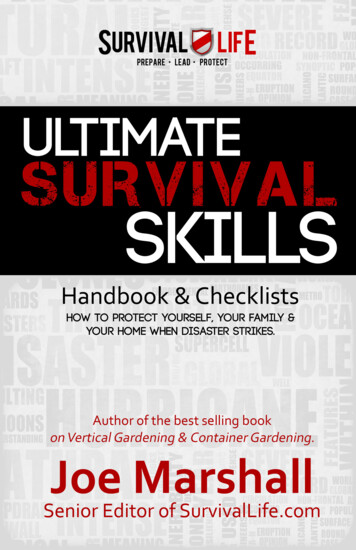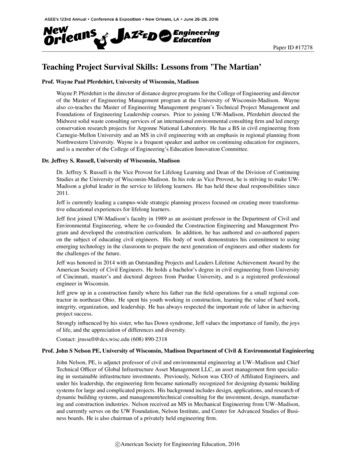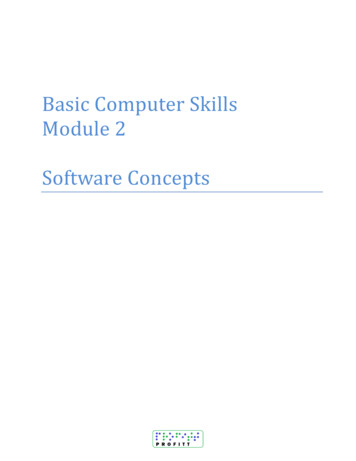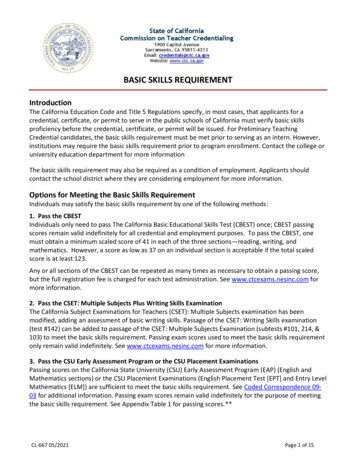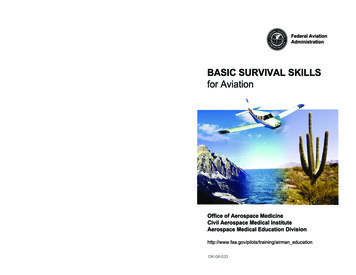
Transcription
OK-06-033
BASIC SURVIVAL SKILLSFOR AVIATIONOFFICE OF AEROSPACE MEDICINECIVIL AEROSPACE MEDICAL INSTITUTEAEROMEDICAL EDUCATION DIVISIONINTRODUCTIONWelcome to the Civil Aerospace Medical Institute (CAMI). CAMIis part of the FAA’s Office of Aerospace Medicine (OAM). As an integralpart of the OAM mission, CAMI has several responsibilities. One responsibility tasked to CAMI’s Aerospace Medical Education Division is to assuresafety and promote aviation excellence through aeromedical education. Tohelp ensure that this mission becomes reality, the Aerospace Medical Education Division, through the Airman Education Programs, established a oneday post-crash survival course.This course is designed as an introduction to survival, providingthe basic knowledge and skills for coping with various survival situationsand environments. If your desire is to participate in a more extensive coursethan ours you will find many highly qualified alternatives, quite possibly inyour local area.Because no two survival episodes are identical, there is no "PAT"answer to any one-survival question. Your instructors have extensive background and training, and have conducted basic survival training for the military. If you have any questions on survival, please ask. If we don't have theanswer, we will find one for you.Upon completion, you will have an opportunity to critique thecourse. Please take the opportunity to provide us with your thoughts concerning the course, instructors, training aids. This will be your best opportunity to express your opinion on how we might improve this course.Enjoy the course.1
NOTESCIVIL AEROSPACE MEDICAL INSTITUTEDirector: Melchor J. Antuñano, M.D.AEROSPACE MEDICAL EDUCATION DIVISIONManager: Brian S. Pinkston, M.D., M.P.H.AIRMAN EDUCATION PROGRAMSTeam Leader: Rogers V. Shaw IILarry “Bo” BoshersJR BrownDonald DeMuthEric “Bart” SimsonRoger StoreyContact InformationFAA, Civil Aerospace Medical InstituteAirman Education Programs, AAM-400P.O. Box 25082Oklahoma City, OK 73125Office: 405-954-4837Fax: ing/airman education2
NOTESTABLE OF CONTENTSPsychology of survival Page 4Search and rescue Page 11Signaling .Page 17Hotland survival .Page 34Coldland survival .Page 44Tropical survival .Page 52Water survival .Page 60Kits, rafts, and accessories .Page 88FAA kits, rafts, and accessories .Page 103Pick-up devices .Page 114Fire building .Page 120First Aid/Self Aid .Page 125Quiz .Page 138Advisory Circular 120-47 .Page AC-13
PSYCHOLOGY OF SURVIVALPost-crash survival should be a subject of interest to all who fly.However, ask yourself the following question; how serious do I take the subject? The answers will vary from person to person, and from personality topersonality. The chances of actually being thrust into a multi-day post-crashsurvival scenario are remote. Still, statistics prove that it can happen. If it happens to you, are you prepared to deal with the stressors associated with a postcrash environment? Before you can start dealing with first aid, or signaling,you must be able to deal with yourself mentally. This chapter will address themany mental stressors that can be involved in a post crash survival situation,and how you can deal with them successfully.When preparing for a potential survival situation you must first admitto yourself that it can happen. Once you have taken this first step, you canthen start preparing for an event that will hopefully never occur.Preparing for an event that may never occur is not always easy.However, if you take the time to prepare yourself both mentally and physically, your chances of survival will increase dramatically. Having the rightframe of mind and being able to think productively are critical. Havingknowledge of the intended use of gear, or the ability to improvise using gear,increases confidence and ultimately your chances of survival.Throughout your survival experience, it will be imperative to maintain a positive mental attitude. Having a positive outlook may be the difference between success and failure. A positive mental attitude will be tested bymany factors. These factors will test your ability to cope with the situation,and will test your will to survive.Several factors that could influence your positive outlook:Post Crash Shock - Being suddenly introduced to a new and threatening environment can be a very traumatic experience. Your ability to handlethis change will depend heavily on your mental state. A person who thinksrandomly and/or irrationally will act in the same manner. After evacuatingthe aircraft and treating for injuries, you should sit down and take an objectivelook at your situation. If you have water, drink it, it will help you to thinkrationally and minimize the risk of shock. (Refer to S.TO.P. on pg. 1-5 formore on this topic.)Injury and Illness - Whatever affects the mind will in turn, affectthe body. This is the principal behind the whole body concept. A continuous,nagging injury can take away from a positive mental attitude. Try to remember that pain is the body's way of telling you something is wrong. Treat the4NOTES
(18) A survival kit, appropriately equipped. Some of the itemswhich could be included in the survival kit are:(i) Triangular cloths.(ii) Bandages.(iii) Eye ointments.(iv) Water disinfection tablets.(v) Sun protection balsam.(vi) Heat retention foils.(vii) Burning glass.(viii) Seasickness tablets.(ix) Ammonia inhalants.(x) Packets with plaster./s/William T. BrennanActing Director of Flight Standardsinjury that causes the pain. If the pain persists, keep your mind busy by doingthe work necessary to be rescued.Thirst and Hunger - For the body and mind to function normally, itmust have food and water. Water is essential to survival. Life expectancywithout water, in extreme conditions, is three days. Even when you are mildlydehydrated, mental skills decrease. When you feel thirsty, you are alreadydehydrated. If you get into the aircraft thirsty, then you are also going intoyour survival experience dehydrated. By entering the aircraft already hydrated,you can prevent this.When dealing with hunger, it is important to remember that the average person can survive 30 days without food. Human beings are creatures ofhabit. We have established our eating schedule over many years (breakfast: 6 8 a.m., lunch: 11 a.m. - 1 p.m., dinner: 5 - 8 p.m.). During a survival episode,when these established times are upon you, the body is expecting to be fed.The expectation can be overwhelming. Try to keep your mind off food by doing the things necessary to be rescued.Cold and Heat – Most survival skills begin with common sense. Ifyou step outside and it is cold, you simply seek a warm shelter. The sheltermay come in the form of a jacket or simply re-entering the aircraft. Either way,you have solved the problem.Fatigue and Sleep Deprivation - Fatigue exist in two forms: physicalfatigue and mental fatigue. Each form of fatigue will hasten the onset of theother (whole body concept). Physical fatigue stems from overexertion. Thebest remedy is prevention. Pace yourself and take frequent rest breaks. Mentalfatigue is caused by the stress placed upon the mind. One remedy for this is toroutinely take your mind off your situation. The best remedy for fatigue is restand sleep. If you are fatigued, the best thing to do is sleep. When sleeping, themuscles relax and the body unwinds. Also it is believed that during sleep themind releases useless information and resets your biological clock. Sleep maybe difficult in this new environment, however, if sleep is put off even for a day,you will become fatigued.Depression – Psychologically, this is potentially the biggest obstaclethat you as a survivor will have to overcome. You, or anyone in your group,who are suffering from depression will experience long periods of sadness ornegative feelings. If you let depression progress it can create feelings of fear,guilt, and helplessness. This may lead to a loss of interest in the basic needs forlife. Depression usually occurs after a person has fulfilled their basic needs,and when there is plenty of “down” time. Keep your mind busy with productive thoughts, such as signaling or improving your shelter.There are many reactions to stress, and they will vary from person toAC-35
person. Fear, anxiety, panic, boredom and helplessness are all common emotions experienced in a survival situation. If you don’t keep your emotions under control they can dramatically reduce your chances for survival.Fear and Anxiety- Fear and anxiety are naturally occurring emotions.Anxiety is simply fear at the subconscious level and is described as a feeling ofuneasiness. In this state a person is worried about what might happen insteadof what is happening. If anxiety is not dealt with, it can cause panic. Panic isan irrational state of mind and is counter-productive to a survival situation.Fear is at the conscious level. You know what frightens you. Fear, left undealtwith, may turn into panic. You must be in control of your fear. To controlfear, you must learn to recognize it. Fear produces symptoms, both physiological and psychological. It is important to remember that the symptoms stemfrom the body going into the "fight or flight" mode. The chart below list symptoms commonly associated with fear.PHYSICALMENTALQuickening of the pulseHostile, irritableDilation of the pupilsTalkative, speechlessPerspiration of hands,soles of feetFrequent urinationFeelings of unrealityLaughing - CryingConfusionDry mouth and throatFeeling of Flight“Fight or Flight”Butterflies in stomachNausea—vomiting(4) Inflation devices, including hand pumps and cylinders (thatis, carbon dioxide bottles), for emergency inflation.(5) Safety/inflation relief valves.(6) Canopy and appropriate equipment to erect the canopy.(7) Position lights.(8) Hook type knife, sheathed and secured by a retaining line.(9) Placards that give the location of raft equipment and are consistent with placard requirements.(10) Propelling devices such as oars, or in smaller rafts, glovepaddles.(11) Water catchment devices, including bailing buckets, reincatchment equipment, cups, and sponges.(12) Signaling devices including:(i) At least one approved pyrotechnic signaling device.(ii) one signaling mirror.(iii) One spotlight or flashlight (including a spare bulb) having at least two "D" cell batteries or equivalent.(iv) One police whistle.(v) One dye marker.1-1 PHYSICAL AND MENTAL SYMPTOMS OF FATIGUE(vi) Radio beacon with water activated battery.Panic – When faced with danger, individuals tend to panic or freeze.Uncontrollable irrational behavior tends to follow. This will vary, in degree,from individual to individual. Panic is brought on by sudden fear. If not dealtwith it can rapidly spread through an entire group.(vii) Radar reflector.Once recognized positive action should be taken to control the fear.These positive steps, along with knowledge and training, will enhance yourwill to survive. Training can help you recognize your reaction to fear.Through training, you should learn to think, plan, and act logically, when confronted with fear.Boredom and Hopelessness – Boredom may be accompanied byfeelings of anxiety, strain, or depression. You should remain mentally focused6(13) One magnetic compass.(14) A 2-day supply of emergency food rations supplying atleast 1,000 calories a day for each person.(15) One saltwater desalting kit for each two persons the raft israted to carry or two pints of water for each person the raft israted to carry.(16) One fishing kit.(17) One book on survival, appropriate for any area.AC-2
AC 120-47 - SURVIVAL EQUIPMENT FOR USE INOVERWATER OPERATIONSDepartment of TransportationFederal Aviation Administrationwith positive task. If there are multiple survivors, you may split up the equipment, and tasks, into responsibility areas. These responsibilities could includesignaling, first aid, water procurement, etc. The key is to continually be working the mind towards positive and productive thoughts.WILL TO SURVIVE6/12/87Initiated by: AFS-220In any survival situation, there are priorities. These priorities are established based on how long a human can survive without each item. The listbelow is based on the "Rule of Three's":1. PURPOSE.The purpose of this advisory circular is to provide information regarding the survival items that should be carried during aircraft extendedoverwater operations. This provides one means, but not the onlymeans, for compliance with the pertinent regulations.2. RELATED FEDERAL AVIATION REGULATIONS (FAR) SECTIONS.121.339, 121.340, 125.209, and 135.167.3. BACKGROUND.While the occurrences of water landings in which aircraft occupants depend on overwater equipment for survival are rare, the possibility doesexist. Therefore, information about the items which should be included inoverwater equipment is important and is provided here. Additional background information and standards are provided in Technical StandardsOrders (TSO) C13e, C69a, C70a, C85, and C91a.4. DISCUSSION.The recommended equipment should meet applicable TSO. This equipment includes, but is not limited to, the following:a. Life preserver for each occupant of the aircraft.b. Rafts or slide/rafts with appropriate buoyancy and sufficient capacity for everyone on board the aircraft and which have a boarding station.c. Rafts (and slide/rafts where appropriate) should be equipped withthe following:(1) Lines, including an inflation/mooring line with a snaphook,rescue or life line, and a heaving or trailing line.(2) Sea anchors.(3) Raft repair equipment such as repair clamps, rubberplugs, and leak stoppers.AC-1Air (3 minutes)Shelter (3 hours)Rest (30 hours)Water (3 days)Food (30 days)Where does the "will to survive" fit in? What is the "will to su
BASIC SURVIVAL SKILLS FOR AVIATION OFFICE OF AEROSPACE MEDICINE CIVIL AEROSPACE MEDICAL INSTITUTE AEROMEDICAL EDUCATION DIVISION INTRODUCTION Welcome to the Civil Aerospace Medical Institute (CAMI). CAMI is part of the FAA’s Office of Aerospace Medicine (OAM). As an integral part of the OAM mission, CAMI has several responsibilities. One responsi- bility tasked to
